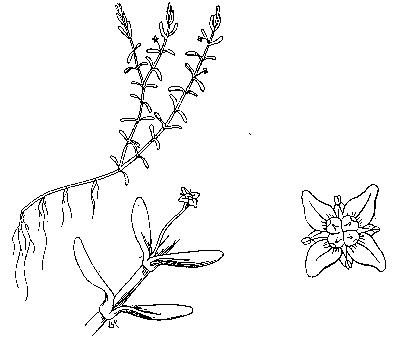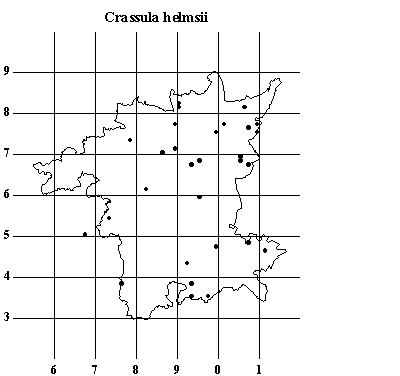
By Will Watson
[The purpose of this article is to remind readers about the problems caused by alien water weeds. Anyone creating a pond should take great care not obtain them and to complain if they see them at pond suppliers, garden centres etc. Crassula helmsii is potentially one of the most serious aliens as it smothers everything else and is very difficult to eradicate. Worcestershire Flora Project would also like any records from the reasonably wild!]
Crassula helmsii, is commonly known as New Zealand Pigmyweed or Australian Swamp Stonecrop. Just to confuse things further it was sold! under the name Tillaea recurva in 1927 as a submerged oxygenating aquatic and it is this name which is still used by the nurseries selling it. In the New Flora of the British Isles (Stace), which follows the new standard list of vascular plants by Douglas Kent, it is referred to as New Zealand Pigmyweed - so this is the name we will use.

Crassula helmsii (drawing adapted from Information Sheet 14 from Centre for Aquatic Plant Management
New Zealand Pigmyweed is a succulent aquatic perennial herb from Australasia. In recent decades it has become a highly invasive plant in the British Isles. It has a creeping growth form, which produces roots from the nodes. It has the ability to reproduce rapidly by vegetative means in the process producing dense mats of vegetation. Submerged populations remain in the vegetative state. The stems have pairs of unstalked opposite leaves (4-20 mm) attached to rigid stems. Where the leaves join the stem there is a collar about 1 mm high. This is a distinctive characteristic which allows the plant to be distinguished from other plants such as Callitriche spp. (Dawson). The leaves have a sharp or bluntish tip. Flowers appear in the emergent growth form only. They are stalked and solitary, forming at the base of the leaves, and four-petelled, white with filaments and black anthers and appear between July and September. It is a well rooted plant and can reach a maximum depth 1.3m in clear water. In water depths of less than 0.5m growth usually becomes dense, with much branching. In summer when the water level draws down the stems become emergent. Under these conditions, the plant forms typical dense mats with sprawling stems with many side shoots.
Competition between New Zealand Pigmyweed and other species often results in total suppression of native plants. Very few plants can out-compete New Zealand Pigmyweed. It has the ability to colonise a variety of different habitats and occurs in both acid and alkaline waters. The smallest stem fragments of this plant strike in moist conditions. It is spread into wildlife ponds by well meaning gardeners, transferred by anglers or occasionally by naturalists pond dipping. It has even known to have been transferred on people's boots. It is currently known from over 1, 000 (Mendick) sites in the British Isles. It is now widespread but local within Worcestershire (the Worcestershire Flora Project has, to date, records from 29 terads (2x2 km squares - see map). It is more common within garden ponds than within the wider countryside since it is sold as an aquatic plant from nurseries. However, because of its rapid means of dispersal it is becoming increasingly common within semi-natural still water-bodies.
Once established it causes all sorts of problems. Having being introduced, by accident or design, into the pond at Berrow Down, Castlemorton Common, it outcompeted all the native aquatic plants. The pond was the only recorded site within the county with all three species of newt. Great Crested Newts Triturus cristatus have now failed to breed within the pond because they cannot lay their eggs on the succulent leaves. In Surrey it is threatening the existence Starfruit Damasonium alisma one of Britain's rarest aquatic plants. The latter is known from only nine locations and at five of the them Pigmyweed is threatening to swamp it. There are many other such examples that could be cited.

Tetrad (2x2 km square) map showing records to date of Crassula
helmsii held by Worcestershire Flora project. Although there are
relatively few records they are (worryingly) scattered throughout
the county. The species undoubtedly also occurs in garden ponds
not seen by the Project.
If you find this plant and are thinking of control do not try and remove it manually, as it is likely you'll do more harm than good, because the plant easily breaks up and each fragment can grow into a new plant. Get further information first. You can obtain the leaflet Crassala helmsii - Focus on control from English Nature. If you still need further advice the Worcestershire Wildlife Trust may be able to help.
| Centre for Aquatic Plant Management. Control of Crassula helmsii (Australian Swamp Stonecrop). Information Sheet 14. Long Ashton Research Station. | |
| DAWSON, F.H. Crassula helmsii - Focus on control. English Nature, Institute of Freshwater Ecology and Institute of Terrestrial Ecology. | |
| DAWSON, F.H. & LEACH, J. April 1999. British Wildlife. Crassula helmsii in the British Isles. | |
| KENT, D.H. 1992. List of vascular plants of the British Isles. Botanical Society of the British Isles. | |
| MENDICK, R. 23rd April 2000 Independent 'Alien invasion destroys pond life.' | |
| PRESTON, C.D., & CROFT, J.M. 1997. Aquatic Plants in Britain and Ireland. Harley Books, Colchester. | |
| STACE, C. 1997. New flora of the British Isles. (Second Edition). Cambridge University Press. | |
| WATSON. W.R.C. 1999. Froglog. Newsletter of the Declining Amphibian Task Force. Number 3 1. 'Amphibians and Crassula helmsii. |
| WBRC Home | Worcs Record Listing by Issue | Worcs Record Listing by Subject |